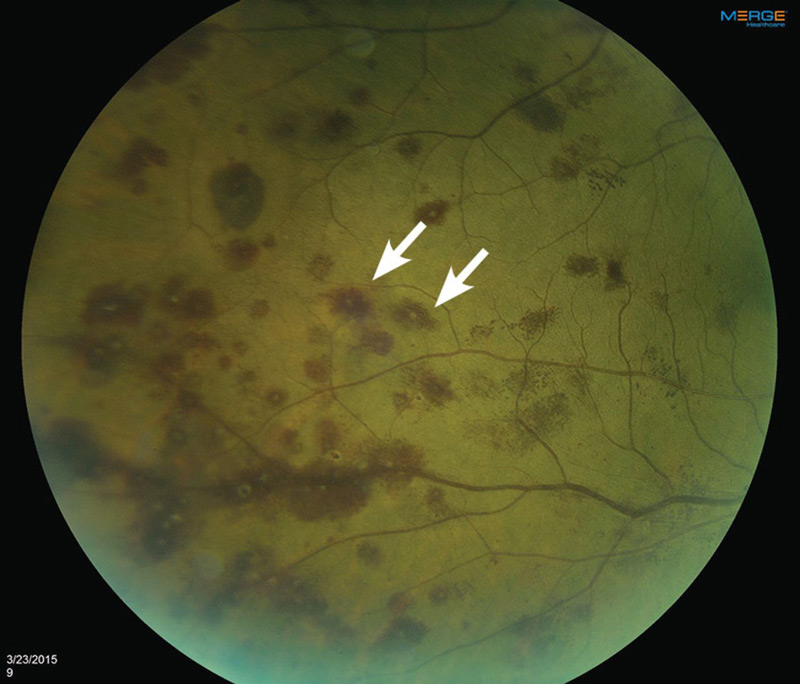Roth spots are small areas where you had a past bleed on your retina. The spot lingers after whatever caused it, and it can be a key sign of several conditions — some of them serious — before you have other symptoms. They typically don’t affect your vision, and treating the cause is usually all it takes for Roth spots to go away.
Advertisement
Cleveland Clinic is a non-profit academic medical center. Advertising on our site helps support our mission. We do not endorse non-Cleveland Clinic products or services. Policy

Roth spots are small areas of bleeding (hemorrhages) that can happen on the retinas inside your eyes. They usually don’t cause any changes you can see or feel, but they’re often a major indicator of health conditions.
Advertisement
Cleveland Clinic is a non-profit academic medical center. Advertising on our site helps support our mission. We do not endorse non-Cleveland Clinic products or services. Policy
Roth spots also aren’t visible to casual observers. The only way someone else can see them is to look inside your eye using a tool like a slit lamp or ophthalmoscope.
In uncommon cases, Roth spots can affect your eyesight under the right circumstances. The most likely way this can happen is if they affect the macula, the part of your retina responsible for the center of your visual field.
Your retina is a light-sensitive layer of cells that covers the fundus, the inside back surface of your eye. Viewed with a slit lamp or ophthalmoscope, a healthy retina looks somewhat orange (though it can lean lighter toward yellowish-orange or darker toward reddish-orange). Also on that surface is a spiderweb-like pattern of blood vessels.
Roth spots stand out because they’re darker — usually a deep orange, maroon or red — and they have a white or pale-colored pinpoint center. The darker patch is from blood that leaked out of a nearby blood vessel. The pale pinpoint dot at the center was the exact site of the retinal bleeding (retinal hemorrhage). It’s white or pale because your body’s natural clotting (hemostasis) process plugged the bleeding and started repairs.
Researchers in the late 1800s initially linked Roth spots to infective endocarditis. That’s when an infection attacks the inside of your heart (usually the valves, but occasionally other internal parts). Most cases where this happens are “subacute,” meaning they aren’t yet causing symptoms severe enough for a person to get medical attention.
Advertisement
The infections can be from bacteria or viruses, and sometimes even from parasites or fungi. If the infection causes infected blood clots to form, those clots can leave your heart and travel anywhere in your body.
The blood vessels in your retinas are tiny, making it easy for a clot to wedge inside and rupture the vessel. That causes bleeding that will later turn into a Roth spot. Those clots can also spread an infection to the inside of your eye and cause endophthalmitis.
But ongoing research shows infective endocarditis only accounts for about 5% of cases involving Roth spots. That research also shows that Roth spots can happen with a huge range of conditions.
Some of the other most common conditions that can cause Roth spots include:
There’s no way to treat Roth spots directly. Instead, the treatments focus on the underlying cause. Roth spots usually get better if you can resolve or manage whatever’s causing them.
The treatments that can help Roth spot-causing conditions can vary widely. Your eye care specialist or healthcare provider is the best person to recommend treatment options and give you more information.
Roth spots are usually just an indication of another condition. In uncommon cases, they may temporarily disrupt your vision, but that usually goes away with treatment of the underlying cause.
But the conditions that cause Roth spots can often be very severe, and a few are dangerous. If an eye care specialist finds one during an eye exam, they’ll refer you to another provider, usually a primary care provider (if you don’t already have one). That provider will work to find the underlying cause and either treat it or refer you to another specialist for further testing and treatment.
Though you can’t see or feel them, and they usually don’t affect your vision, Roth spots are often a sign of something else that needs treatment. Your eye care specialist will likely refer you to another healthcare provider to get a diagnosis and treatment. Most causes are treatable, and Roth spots usually go away when you resolve or manage the underlying cause. That way, you can move forward with Roth spots out of sight, mind and your eyes.
Advertisement
Cleveland Clinic’s ophthalmologists and optometrists have the highest training available. We provide exams, vision correction and care for many eye conditions.

Last reviewed on 09/29/2024.
Learn more about the Health Library and our editorial process.